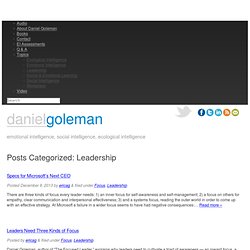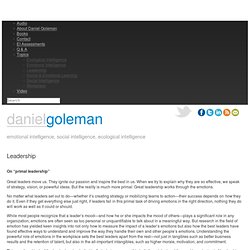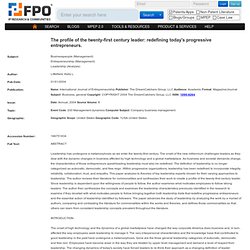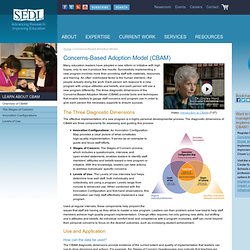

1. Inspire Me With Your Vision For Libraries. In a previous post I listed 24 library leadership qualities that will inspire me to be a loyal follower. 1.

I will follow someone who has a vision of how libraries can take the world to a better place. A vision provides an inspirational statement that captures the essence of an ideal future. Kids - Earth - Floods. The Good, The Bad and The Ugly, or, Why It's a Good Idea to Evaluate Web Sources. Concerns-Based Adoption Model (CBAM) Video - Innovation Configurations. Cbamproject - Stages of Concern. Leadership. There are three kinds of focus every leader needs: 1) an inner focus for self-awareness and self-management; 2) a focus on others for empathy, clear communication and interpersonal effectiveness; 3) and a systems focus, reading the outer world in order to come up with an effective strategy.

At Microsoft a failure in a wider focus seems to have had negative consequences:… Read more » Daniel Goleman, author of “The Focused Leader,” explains why leaders need to cultivate a triad of awareness — an inward focus, a focus on others, and an outward focus. Watch the video at HBR.org The emotional intelligence model can be looked at in terms of what it means to be intelligent about emotions, which is being self-aware, knowing your own feelings, and why you feel that way. It’s about managing those emotions. Toxic emotions at work: Drew Hansen covers Leadership: The Power of Emotional Intelligence at Forbes.com. Leadership. On “primal leadership” Great leaders move us.

They ignite our passion and inspire the best in us. When we try to explain why they are so effective, we speak of strategy, vision, or powerful ideas. But the reality is much more primal: Great leadership works through the emotions. No matter what leaders set out to do—whether it’s creating strategy or mobilizing teams to action—their success depends on how they do it. Even if they get everything else just right, if leaders fail in this primal task of driving emotions in the right direction, nothing they do will work as well as it could or should. Daniel Goleman on Leadership and Emotional Intelligence. Watch a video of Goleman being interviewed about emotional intelligence here .
Last week, when I mentioned to my Twitter network that I needed to do some reading on ‘Leadership’, quite a few recommended the work of Daniel Goleman . Then, when I looked at the ‘Further Reading’ section of Jo Owen’s that I’ve just started reading , Goleman was mentioned again. Cited some contributions Goleman made to the . Thankfully, I’ve access to this electronically through being a student at the University of Durham . What follows are my notes and thoughts on 5 articles (and a letter) by Goleman, all published in the Each subtitle is the name of Goleman’s article, along with the year published. Six Emotional Leadership Styles.
Disciplines > Leadership > Six Emotional Leadership Styles Visionary | Coaching | Affiliative | Democratic | Pace-setting | Commanding | See also Daniel Goleman, Richard Boyatzis and Annie McKee, in Primal Leadership, describe six styles of leading that have different effects on the emotions of the target followers.

These are styles, not types. Any leader can use any style, and a good mix that is customised to the situation is generally the most effective approach. The Visionary Leader. R0401H_pdf.fm. The profile of the twenty-first century leader: redefining today's progressive entrepreneurs. Leadership has undergone a metamorphosis as we enter the twenty-first century.

The onset of the new millennium challenges leaders as they deal with the dynamic changes in business affected by high technology and a global marketplace. As business and societal demands change, the characteristics of those entrepreneurs spearheading leadership must also be redefined. The definition of leadership is no longer categorized as autocratic, democratic, and free reign. Within progressive organizations, leadership has been redefined to incorporate integrity, reliability, collaboration, trust, and empathy.
This paper analyzes to theories of top leadership experts chosen for their varying approaches to leadership. Goleman leadership styles. Leadership%20that%20gets%20results. Goleman-%20Socially%20Intelligent%20Leader. Primal-leadership. Store - Concerns-Based Adoption Model. Home | Concerns-Based Adoption Model Many education leaders have adopted a new reform or initiative with high hopes, only to see it produce few results.

Successfully implementing a new program involves more than providing staff with materials, resources, and training. An often overlooked factor is the human element—the people actually doing the work. Each person will respond to a new program with unique attitudes and beliefs, and each person will use a new program differently. The three diagnostic dimensions of the Concerns-Based Adoption Model (CBAM) provide tools and techniques that enable leaders to gauge staff concerns and program use in order to give each person the necessary supports to ensure success.
The Three Diagnostic Dimensions The effective implementation of a new program is a highly personal developmental process. Innovation Configurations: An Innovation Configuration Map provides a clear picture of what constitutes high-quality implementation. Use and Application Yes. Untitled. The Concerns-Based Adoption Model: A Developmental Conceptualization of the Adoption Process Within Educational Institutions. The Concerns-Based Adoption Model (CBAM), a representation of the process by which an educational institution adopts an innovation, views adoption as a developmental process involving complex interaction between an adopting institution, a user system, and a resource system.

The resource system is usually a formal organization whose expert knowledge of the innovation is available to the user system. This interaction, called collaborative linkage, is ideally characterized by open communication, which allows the resource system to assess the individual user's needs and concerns, and to select personalized intervention strategies based on this assessment.